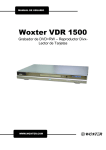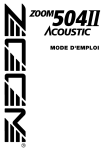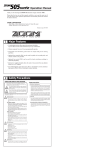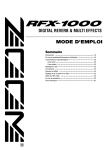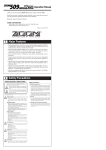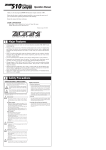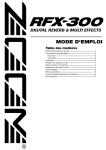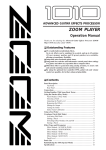Download Zoom 508 Network Card User Manual
Transcript
Operation Manual Thank you for selecting the ZOOM 508 (hereafter simply called the "508"). Please take the time to read this manual carefully so you can get the most out of your 508 and ensure optimum performance and reliability. Retain this manual for future reference. ZOOM CORPORATION NOAH Bldg., 2-10-2, Miyanishi-cho, Fuchu-shi, Tokyo 183, Japan PHONE: 0423-69-7116 FAX: 0423-69-7115 Printed in Japan 508-5000 1 Major Features • Compact, dedicated delay unit with up to 4000 ms delay time and eight delay types (Four types x two variations). • On-board "Zfx-2" DSP (Digital Signal Processor) developed by Zoom, and an innovative design used solely for its delay effects. Achieves superior quality delay sound on a par with high-end devices. • You can switch between 24 patches to store diverse settings based on your preference. • Seamless function that enables smooth patch transitions without cutting the delay sound when the patch is switched. • Ample functions to support powerful live performances, including a hold function for continuing the delay sound until the foot switch is pressed, and a tap function for setting the delay time in the interval between when the foot switch is pressed. • Integrated auto-chromatic tuner for guitar. You can tune your insturment easily anywhere, any time. You can also leave the tuning function disabled all the time. • The optional FP01 expression pedal enables foot control of the mix level for the delay sound. • Dual power supply design allows the unit to be powered from an alkaline battery (6LR61) or an AC adapter. 2 Safety Precautions USAGE AND SAFETY PRECAUTIONS In this manual, symbols are used to highlight warnings and cautions for you to read so that accidents can be prevented. The meanings of these symbols are as follows: Warning This symbol indicates explanations about extremely dangerous issues. If users ignore this symbol and handle the device incorrectly, serious injury or death could result. Caution This symbol indicates explanations about dangerous issues. If users ignore this symbol and handle the device the wrong way, bodily injury and damage to the equipment could result. Please observe the following safety tips and precautions to ensure hazard-free use of the 508. About power Warning Since power consumption of this unit is fairly high, we recommend the use of an AC adapter whenever possible. When powering the unit from a battery, use only an alkaline type. AC adapter operation • Be sure to use only an AC adapter which supplies 9 V DC, 300 mA and is equipped with a "center minus" plug (Zoom AD-0006). The use of an adapter other than the specified type may damage the unit and pose a safety hazard. • Connect the AC adapter only to an AC outlet that supplies the rated voltage required by the adapter. • When disconnecting the AC adapter from the AC outlet, always grasp the adapter itself and do not pull the cable. • If the unit is not to be used for a long time, disconnect the AC adapter from the outlet. Battery operation • Use only a 9 V (alkaline) battery (6LR61). • The 508 cannot be used for recharging. Pay close attention to the labelling of the battery to make sure you choose the correct type. • If the 508 is not to be used for an extended period of time, remove the battery from the unit. • If battery leakage has occurred, wipe the battery compartment and the battery terminals carefully to remove all remnants of battery fluid. • While using the unit, the battery compartment cover should be closed. Environment Caution • • • • Avoid using your 508 in environments where it will be exposed to: Extreme temperature High humidity or moisture Excessive dust or sand Excessive vibration or shock Handling Caution • The 508 is a precision instrument. Except for the foot switches, do not push other parts with your feet or subject them to strong force. • Take care that no foreign objects (coins or pins etc.) or liquids enter the unit. • Be sure to turn the power to all equipment off before making connections. • Before moving the unit, turn the power off and disconnect all cables and the AC adapter. Alterations Caution Never open the case of the 508 or attempt to modify the product in any way since this can result in damage to the unit. Usage precautions Electrical interference For safety considerations, the 508 has been designed to provide maximum protection against the emission of electromagnetic radiation from inside the device, and from external interference.However, equipment that is very susceptible to interference or that emits powerful electromagnetic waves should not be placed near the 508, as the possibility of interference cannot be ruled out entirely. Whatever the type of digital control device, the 508 included, electromagnetic damage can cause malfunctioning and corrupt or destroy data. Since this is an ever-present danger, thorough care should be taken to minimize the risk of damage. Cleaning Use a soft, dry cloth to clean the 508. If necessary, slightly moisten the cloth. Do not use abrasive cleanser, wax, or solvents (such as paint thinner or cleaning alcohol), since these may dull the finish or damage the surface. Connecting cables and input and output jacks You should always turn off the power to the 508 and all other equipment before connecting or disconnecting any cables. Also make sure to disconnect all cables and the AC adapter before moving the 508. 3 What Are Banks and Patches? 4 PATCH LIST The 508 has memory capacity for 24 patches. At the factory, these are programmed with recommended settings. The user can freely change the contents of any patch, and it is also possible to restore the factory settings. • PATCH A group of the settings for a certain effect type is called a PATCH. The 508 comes with 24 preset patches which can be changed (edited) by the user. BANK PATCH • BANK The 508 calls up patches in sets of four, called a "bank". A b BANK F BANK E BANK d BANK C BANK b BANK A PATCH 1 PATCH 2 PATCH 3 PATCH 4 PATCH 1 PATCH 2 PATCH 3 PATCH 4 PATCH 1 PATCH 2 PATCH 3 PATCH 4 PATCH 1 PATCH 2 PATCH 3 PATCH 4 PATCH 1 PATCH 2 PATCH 3 PATCH 4 PATCH 1 PATCH 2 PATCH 3 PATCH 4 C d E F PATCH NAME LEAD DELAY SPACY ARPEGGIO SOUND ON SOUND JAZZ CLUB MUTE CUTTING DEEP OLD DELAY ODD METER WARM WRAP DOTTED EIGHT SWEET TONE TRIPLET EDGE DELAY HOLLOW BODY BRIGHT DELAY RHYTHM BOUNCE ETHNIC MY ROOM 150 BPM SHADOW SHORT REVERB HQ DUBBLING 4 SEC DELAY SOFT ECHO COMB FILTER SHORT ECHO 1 2 3 4 1 2 3 4 1 2 3 4 1 2 3 4 1 2 3 4 1 2 3 4 COMMENT Long delay for lead play Fantastic effect by twin delay Play Brian's harmony Room ambience for jazz guitar Good for muted cutting play Old fashioned echo sound Progressive rock? Warm echo sound Makes dotted eighth note Makes triplet rhythm Enhanced effect Makes acoustic feel sound using comb filter Long delay effect with bright tone Play sixteenth single Imagine Arabian desert Room ambience using stereo echo Playing quarter note makes eighth note 70's echo sound Small reverberation effect Fat doubling effect, good for distortion sound Ultra long delay with much feedback Analog feeling echo sound Intense comb filter effect Short echo sound for global use 5 Seamless Function The seamless function can be used in two ways. One method is to leave the time for the delay sound as it is set in the patch. The other method is to force the delay sound to decrease at the timing decided by the seamless function. It is not necessarily preferable to leave the seamless function on normally. Rather, it should be switched on and off to suit the musical circumstances under which patches are switched. (The on/off status of the seamless function can be stored for each patch.) With conventional delay and multi-effect units, the sound cuts off unnaturally when patches are switched. For example, when switching from a solo performance using a long delay to a patch with a short delay for backing, the delay of the previous patch stops abruptly the instant before the next patch starts, causing the reverberation to sound unnatural. This type of problem experienced by guitarists is solved by the 508's revolutionary seamless function. This function holds the delay sound of the previous patch after it has been switched, so that the transition from one patch to the next is performed smoothly. By combining the seamless and hold functions, you can perform solo by using new patches while holding the riff and rhythm pattern (repeat playback). For details, see [12. Effect Parameters] . Conventional patch switching Seamless function Patch is switched PATCH 1 Patch is switched PATCH 2 PATCH 1 Sound is cut PATCH 2 PATCH 1 delay The delay sound of PATCH 1 overlaps the sound of PATCH 2 6 Controls, Functions and Connections Front Panel OUTPUT INPUT Displays the selected bank (A-F) and patch (1-4). In the 508, this indicator shows that the tuner is active, and it serves as a gauge for fine tuning your instrument. • Edit mode Displays the value of the selected effect parameter. • BATTERY EMPTY WARNING display • Bypass/Tuner mode When the unit is powered from the battery, this indicator begins flashing to warn that the battery is running low. When the contents of patches are to be stored, this key is used for putting the unit in store standby status and to execute the store function. BANK HOLD DELAY TYPE •DELAY •TWIN DELAY •ECHO •TMULTI TAP (x100mS) DLY TIME (x1mS) STORE FEEDBACK EFFECT MIX EDIT Shows the pitch of the input signal. + TUNER CAL. EDIT VAL. BANK TONE • Setting of direct load function When the STORE key is pressed for at least 1 second during Play mode (during performance), the direct load function can be switched on or off. [For details, see 10. Patch Switching (Application: Direct Load OFF).] Displays information required to operate the 508. • Play mode TUNER indicator STORE key DISPLAY SEAMLESS MODE – • Play mode The status of the DELAY indicator and the SEAMLESS indicator (illuminated, flashing, or off) shows whether the effect module and the Seamless function are on or off respectively. • Edit mode The status of the DELAY indicator and the SEAMLESS indicator (illuminated or off) shows whether the effect module and the Seamless function are on or off respectively. Also, the effect parameter selected for editing flashes. HOLD/TAP DOWN BYPASS PARAMETER CURSOR indicator UP EDIT key (for creating your own patches) • Bypass/Tuner mode This key serves to toggle between the Play mode and Edit mode (mode for creating patches to suit your taste). In Edit mode, this key can be used to select the effect parameters you wish to change. Also, when the effect parameter HOLD/TAP is selected, press this EDIT key to return from the Edit mode to the Play mode. Indicators function as tuning meter. VALUE +/- keys • Play mode • Setting of bank hold function The keys serve for bank switching. When the EDIT key is held down for at least 1 second in Play mode, the bank hold function is turned on or off. [For details, see 9. Patch Switching (Application: Bank Hold ON).] • Edit mode The keys serve for changing the effect parameter. • Bypass/Tuner mode The keys serve for setting the tuner reference pitch (calibration). PATCH UP (right)/DOWN (left) pedals Rear Panel • Play mode The pedals serve for patch switching. Pressing both pedals simultaneously activates the Bypass/Tuner mode. • Edit mode The pedals serve for selecting effect parameters. Also, when a parameter other than Hold/Tap is currently selected, pressing both pedals simultaneously activates the hold function (for extending the delay sound) and tap function (for setting the delay time in the intervals between pressing the foot switch). • Bypass/Tuner mode Pressing either pedal cancels the Bypass/Tuner mode to return to Play mode. INPUT jack Serves for connecting the guitar. When the unit is powered by the battery, this jack also functions as the power on/off switch. The 508 is powered on by plugging a shielded cable into this jack. When the unit is not in use, the cable should be disconnected to prevent battery drain. DC IN (AC adapter) jack Serves for connecting an AC adapter (Zoom AD-0006) which delivers 9 VDC, 300 mA with a "center minus" plug configuration. The 508 is powered on by plugging an AC adapter into this jack. CONTROL IN jack When the optional FP01 expression pedal and FS01 foot switch are connected to this jack it can serve as the external control jack. When the optional expression pedal FP01 is connected, it can serve for controlling the mix level of the effect. When the optional foot switch FS01 is connected, chorus can be switched on or off externally. INPUT DC 9V CONTROL IN OUTPUT OUTPUT jack ZOOM CORPORATION 300mA MADE IN JAPAN [PHONES] This jack is for the output signal from the 508. You can connect either a single guitar amplifier, using a monaural shielded cable, or two guitar amplifiers, using a Y-type stereo shielded cable, or a pair of stereo headphones. If the volume level is low when using headphones, use headphones with low impedance (32 ohms or less). 7 Selecting Patches Bank switching Banks A, b, C, d, E, F are available BANK F PATCH DOWN PATCH UP PATCH 1 PATCH 2 PATCH 3 PATCH 4 Patch switching 24 patches are available BANK E PATCH 1 PATCH 2 PATCH 3 PATCH 4 The 24 patches can be easily selected by pressing the patch pedals. The right patch pedal switches to the next patch and the left patch pedal switches to the previous patch. BANK UP BANK d PATCH 1 PATCH 2 In the initial condition, the 508 is set up so that the patch pedals select patches continuously, but you can also set up the unit so that patches are switched only within a certain bank of four patches. [For details, see section 9 Patch Switching (Application: Bank Hold ON).] PATCH 3 PATCH 4 BANK C PATCH 1 PATCH 2 BANK DOWN PATCH 3 PATCH 4 Banks are selected with the VALUE +/keys. Press the VALUE+ key to select the next bank, and the VALUE- key to select the previous bank. BANK b PATCH 1 PATCH 2 For example, to switch from Patch 2, Bank A to Patch 3, Bank C, the patch pedal would have to be pressed nine times. Instead, you can press the VALUE+ key twice to switch to Bank C, and then press the patch pedal (UP) just once to select Patch 3. PATCH 3 PATCH 4 BANK A PATCH 1 PATCH 2 Bank/patch switching when Bank Hold is off (initial setting) PATCH 3 PATCH 4 8 Using the Bypass/Tuner Mode The effects of the 508 can be turned off (bypassed) temporarily, so that only the original sound of the instrument is heard. In this mode, the auto-chromatic tuning function via the LED display is also active. Tuner ON/OFF Pressing the EDIT key and the STORE key simultaneously for more than one second in Play mode will allow you to select whether or not to activate the tuning function in Bypass mode. When you change the setting, the display will show"tunEr oFF" (tuning function off) or "tunEr on" (tuning function on) according to the setting. Calibration Select reference pitch for auto-chromatic guitar tuner (calibration). * The reference pitch (A) can be adjusted in the range from 435 to 445 Hz. When the BANK key is pressed in Bypass/Tuner mode, this is shown as "35" to "45" on the display for a second. Adjust to the suitable value. At power-on, the setting is 440 Hz (40). Bypass mode Pressing both patch pedals simultaneously activates the Bypass mode. Bypass ON/OFF Press both pedals together The bypass function is invoked by pressing the left and right patch pedals simultaneously. To cancel the Bypass/Tuner mode, just press one of the patch pedals. To cancel the Bypass mode, simply press one of the patch pedals. The unit then reverts to the previously selected patch. Currently selected patch is displayed Press Release immediately Tuning function (only when the tuning function is ON) Tuner mode The 508 is initially set so that the auto-chromatic tuning function for the guitar activates automatically when the Bypass mode is invoked. In Bypass mode, pick an open string to be tuned. The closest note will be shown on the display. Input signal standby condition Regular tuning Do = C Fa# = F# Re# = D# Regular tuning Do# = C# Mi = E 6th string 1st string So = G Regular tuning Re = D La = A 5th string Regular tuning 3rd string La# = A# Regular tuning 4th string Fa = F So# = G# Si = B 2nd string When the tuning function is active, the parameter cursor LEDs serve as tuning meter, designed to enhance tuning precision during fine adjustments. Turning tuning function off If you do not want to activate the tuning function in Bypass Pitch is too high Correctly tuned Pitch is too low mode, press the STORE and EDIT keys simultaneously for more than one second in Play mode. The tuning function will be turned off, and this setting will be stored even when the power is turned off. When you turn the function off, the display will show "tunEr oFF" (tuning function off). To turn the tuning function on, press the same keys simultaneously again. The display will show "tunEr on" (tuning function on). NOTE: Please note that the tuning function may not operate properly if other effect modules between the guitar and the 508 are on. 9 Patch Switching (Application: Bank Hold ON) In the initial setting, the patch pedal switches all patches in order, regardless of the bank divisions. Bank Hold ON Keeping the EDIT key depressed for at least 1 second activates Bank Hold. To cancel Bank Hold, press the EDIT key again for 1 second. The bank hold function limits switching to the four patches within a bank. When this function is activated, the patch pedals switch in order between the patches in the current bank only. Bank switching Banks A, b, C, d, E, F can be switched. To activate this function, hold the EDIT key down for at least 1 second in Play mode. The BANK HOLD indicator will light. To turn the function off, again hold the EDIT key down for at least 1 second. The BANK HOLD indicator will go off. PATCH DOWN PATCH UP Patch switching 4 patches within bank can be switched. Banks can be switched using the VALUE +/- keys. Bank/patch switching when Bank Hold is on BANK F PATCH 1 BANK E PATCH 1 PATCH 2 PATCH 1 PATCH 2 PATCH 2 PATCH 3 PATCH 4 PATCH 1 PATCH 1 PATCH 2 PATCH 1 PATCH 2 PATCH 2 PATCH 3 PATCH 4 PATCH 3 PATCH 4 PATCH 3 PATCH 4 PATCH 3 PATCH 4 BANK d BANK C BANK b BANK A PATCH 3 PATCH 4 BANK HOLD ON NK BA NK UP BA DO WN BANK HOLD OFF 10 Patch Switching (Application: Direct Load OFF) In the default condition, the 508 is set up in such a way that pressing a patch pedal immediately switches the patch and alters the output sound. This is called Direct Load ON. This switching principle is most convenient when the desired patches are adjacent or close to each other. However, when wanting to switch to a patch that is further away, it may be desirable not to activate the sound of the other patches in between. When this is desired, turn the Direct Load function off as follows. When Direct Load has been turned off, switching banks and patches has no effect until the user confirms the selection. DIRECT LOAD OFF Keeping STORE key depressed for 1 second turns Direct Load off. The same procedure serves to turn it on. Bank switching Banks A, b, C, d, E, F can be switched. PATCH DOWN For example, when going from patch 1 to patch 4 with Direct Load active, patches 2 and 3 will briefly be heard when the patch UP pedal is pressed three times. When Direct Load is off, pressing the patch UP pedal will change the number on the display (the number flashes), but until the user confirms the choice, the sound remains that of patch 1. PATCH UP Patch switching Patches can be switched. Confirming a patch When display indication flashes, pressing both patch pedals together confirms the patch and switches the output sound. To turn Direct Load on or off, keep the STORE key depressed for at least 1 second. To confirm a choice after selecting a patch with Direct Load off, press both patch pedals simultaneously. Press both pedals together Example: Switching from patch 1 to patch 4 Patch switching completed Confirm 11 Editing Patches The 508 comes with 24 predefined patches. However, the 508 offers many more possibilities for combining effects in innovative ways. To discover these possibilities, we recommend that you try changing the parameters (elements that make up patches) to create your own patches. This operation is called editing, and is done in the Edit mode. The correlations between parameter cursor LEDs and parameters are shown below. • 1st parameter cursor LED: Delay type selection • 2nd parameter cursor LED: Delay time/delay time setting (in units of 100 ms) • 3rd parameter cursor LED: Delay time/delay time setting (in units of 1 ms) • 4th parameter cursor LED: Feedback setting • 5th parameter cursor LED: Delay tone setting. • 6th parameter cursor LED: Delay mix level setting • 7th parameter cursor LED: Seamless function setting • 8th parameter cursor LED: Hold/tap function switching To switch from normal Play mode to Edit mode, press the EDIT key briefly (for less than 1 second). * Note that if the EDIT key is held down for 1 second or longer, the Bank Hold mode will be activated. (1) While still in Play mode, select the patch you wish to edit. Use the VALUE +/- keys to change parameters. By pressing one of the keys briefly, the value will increment or decrement by 1. By holding one of the keys down, the value will increment or decrement continuously. By holding down one key and then pressing the other key, the values will change rapidly in the direction of the first key pressed. Also, pressing the VALUE +/- keys simultaneously will skip the value of some parameters. For an explanation of the various parameters, see 12 Effect Parameters. When the EDIT key is pressed while the eighth parameter (Hold/Tap) cursor LED flashes, Edit mode is canceled and the unit returns to Play mode. Immediately after switching from Play mode to Edit mode, the parameter cursor flashes at the highest position (Delay type parameter), and the setting for that parameter is displayed. This means that the Delay type parameter has been selected for editing. (2) Press the EDIT key to activate the Edit mode. Hd In Edit mode, the EDIT key is used for selecting the parameter for editing. Each time the EDIT key is pressed the parameter cursor moves one position down. The flashing position shows which parameter is selected for editing. (1) Use the EDIT key or patch pedal to select the parameter you wish to change. A1 tp tp (2) Use the VALUE +/- keys to adjust the parameter. (3) While the eighth parameter cursor LED is flashing, press the EDIT key to return to Play mode. 12 Effect Parameters Patches in the 508 are called effect parameters, made up of elements that decide the tone. Some effect parameters decide the delay type (delay functions and characteristics), and others decide the delay time and feedback. PARAMETER 1 Selects the delay type. Two variations can be selected for each of DELAY, TWIN DELAY, ECHO, and MULTI TAP DELAY, for a total of eight types. The setting ranges are nd , pd , DELAY type PARAMETER 2 DELAY TIME (X100 ms) PARAMETER 3 DELAY TIME (X1 ms) PARAMETER 4 PARAMETER 5 , nE , SE NORMAL TWIN DELAY (MON) pd nt Stereo version of NORMAL DELAY. The delay sound is output alternately from the left and right channels. Twin delay enabling two types of delay having different delay times, Tap 1 (delay time of 4000 ms max.) and Tap 2 (half the delay time of Tap 1). When feedback is set to zero, triple overlay can be achieved (creates the impression that three players are performing). , M4 , M6 Range of setting St Delay time is set in units of 1 ms. This parameter is used for fine adjustment of the delay time roughly set with PARAMETER 2. The larger the value, the longer the delay time. When PARAMETER 2 is set to "0", the setting range becomes 1 - 99. When you press the +/- keys simultaneously, the value changes in tens -- 10, 20...90, 99. Adjusts the feedback of the delay time. The larger the value, the longer the delay time. When you press the +/- keys simultaneously, the value changes in tens -- 10, 20...90, 99. 0 ↔ 99 The function of this parameter varies depending on the setting range and the selected delay type. In this range, the function of the parameter varies depending on the delay type selected in PARAMETER 1. • When a delay type has been selected Sets the delay sound Hi Damp (effect where the high range is suppressed as the delay repeats). Smaller values result in faster suppression of the high-range delay. TONE • When a type other than delay type has been selected Sets the delay sound Hi Cut (smaller values result in the high-range delay is cut). In this range, the parameter determines the delay sound Hi Boost (degree to which the high-range delay is boosted) for any delay type. Larger values result in brighter, harder tone. Range of setting 41 ↔ 50 Adjusts the mix of the delay for the original sound. Larger values result in a higher mix level for the delay sound. When you press the +/- keys simultaneously, the value changes in tens -- 10, 20...50. Range of setting 0 ↔ 50 nE Stereo version of NORMAL TWIN DELAY. Tap 1 is output to the left channel and Tap 2 to the right channel. The larger the value, the longer the delay time. 0 ↔ 99 Using a short delay time will create an echo effect similar to reverb, and using a long delay time will create a spacious echo effect you might experience on top of a mountain. HINT Sets the length of the overlap of delay sound by the seamless function when the current patch is switched to a different patch. Range of setting SEAMLESS MODE PARAMETER 8 HOLD/TAP oF , 0.5 , 1.0 ••• 9.5 , 10 , oo When the display indicates oF, the seamless function is off. In the range from 0.5 to 10, the time set by this parameter will overlap, regardless of the delay time set in the patch. When the display indicates oo, the delay sound is held for a period of time set in the patch. This parameter is used when the optional FS01 foot switch is connected to the CONTROL IN jack, or when the left and right patch pedals are used to invoke the hold function (for holding the delay sound) or the TAP function (sets the delay time for when the foot switch is pressed). The function used is set for each patch. Range of setting Hd , tP When the display indicates Hd, the hold function can be used. When the display indicates tP, the tap function can be used. MULTI TAP DELAY (4 TAPS) MULTI TAP DELAY (6 TAPS) SE M4 M6 Stereo version of ECHO. Rhythmical multi-tap delay enabling four types of tap (independent delay). Multi-tap delay enabling four types of tap. Selection of parameters to ! change As described in 11. Editing Patches, parameters to be edited are selected by repeatedly pressing the EDIT key, but you can also use the patch pedals for this purpose. Press the PATCH UP pedal (right patch pedal) to move the parameter cursor from the bottom up. performance will be played back to the end, then the Hold function will be canceled. (The HOLD/TAP indicators will go off.) Original dry sound Effect sound Sampling Time Press the PATCH DOWN pedal (left patch pedal) to move the parameter cursor from the top down. HINT To turn the effect off, enter Edit mode and select a parameter other than Hold/Tap, and press the left and right patch pedals simultaneously. This operation turns the effect off, and the parameter cursor LEDs for DELAY TYPE will go off. Further, the display will change as below. Display for effect off when the Delay Type parameter has been selected. oF Display for effect off when another parameter (except Hold/Tap) has been selected. -- # Master level adjustment With the 508 you are also able to set the master effect level that governs the overall effect output level. The master effect level is adjusted in Play mode. Hold the VALUE +/- keys down simultaneously for at least 1 second. The current master level will be displayed for 1 second. While the level is being displayed, use the VALUE +/- keys to change it. The setting range is 0-50. (Default value = 40) The unit does not store the setting for the master effect level. Each time the power is turned on it has to be set again. $ Auto mode operation Press the FS01 while playing the guitar, and sampling starts. Sampling ends when the duration of the delay time set for that patch, expires, and playback will begin automatically. (The HOLD/TAP indicator will light up.) When you press the FS01 again, the recording will be played back just one more time to the end and the Hold function will be canceled. (The HOLD/TAP indicator will go off.) Original dry sound Effect sound Sampling Delay time Time To turn the effect on again, enter Edit mode (regardless of the parameter currently selected) and press both patch pedals simultaneously. The parameter setting will return to the original value (the parameter value immediately before being turned off). Also, the effect can be turned off by pressing either of the VALUE +/- keys in Edit mode. HINT Press foot switch Press foot switch Press foot switch (first time) (second time) (third time) Sampling Sampling Sampling Hold function starts stops plays back canceled @ Switching effects on and off Normally, the bypass function is used for turning the delay function off during performance. However, a patch should be prepared with the effect turned off if you do not want to use a delay sound with the next patch when using the seamless function to hold the delay sound of the previous patch. HINT PARAMETER 7 MULTI TAP DELAY type STEREO TWIN DELAY NORMAL ECHO (MONO) STEREO ECHO 0 ↔ 40 Range of setting *When types are switched the other parameter settings do not change. ECHO type Delay time is set in units of 100 ms. In combination with PARAMETER 3, you can set from 1 ms up to 4000 ms. When you press the +/- keys simultaneously, the value changes in tens -- 10, 20...90, 99. 0 ↔ 40 EFFECT MIX St nd Range of setting PARAMETER 6 , Monaural delay enabling extremely long delay of 4000 ms maximum. Range of setting FEEDBACK nt TWIN DELAY type NORMAL DELAY PINGPONG DELAY Delay type In compact effectors, the delay type is equivalent to the individual effectors, and the other parameters are equivalent to the control knobs on the effector. This section describes all the effect parameters constituting the patches of the 508. Hold function The Hold function allows you to press the optional FS01 foot switch to start sampling (recording) the performance, and play back the recording repeatedly until you press the foot switch again. The Hold function has two modes; Manual mode that allows you to specify the end point of sampling using the foot switch, and Auto mode in which the sampling operation is performed for a period of delay time set in the patch. Preparation for using the Hold function To use the Hold function, connect the FS01 foot switch to the CONTROL IN jack. Also, select the patch that has a setting of Hd for the Hold/Tap parameter. Manual mode operation Press the FS01 to start sampling while playing the guitar, and press the FS01 again before the delay time set in the patch expires. The performance made from when you press the FS01 first until when you press it the second time will be sampled and held (played back repeatedly). (The HOLD/TAP indicator will light up.) When you press the FS01 for the third time, the sampled Press foot switch (first time) Sampling Sampling starts stops Press foot switch (second time) Sampling Hold function plays back canceled * In Manual mode you may want to set the delay time longer, and in Auto mode set it so that it will match the tempo of the song. *The hold function can be used by pressing the left and right patch pedals simultaneously instead of pressing the FS01. However, for this case, it can be used only in the status selected for the Hold/Tap parameter in Edit mode. * When connecting the FS01, be sure to switch the power off beforehand. Also, if the FS01 is not working as you had expected, switch off the unit and then switch it on again. HINT % TAP The tap function sets the delay time to match the time between when the FS01 is pressed once and then again. This is a handy function for setting the delay time to match the tempo of the music. To use the tap function, the FS01 foot switch must be connected via the CONTROL IN jack. Also, the patch must be selected in advance with the setting tP for the Hold/Tap parameter. Once preparations are complete, press the FS01 and then press it once again within 4 seconds. This operation will set the interval for the delay time of the patch currently selected. Measuring delay time (valid up to 4 seconds) Time Press foot switch (first time) Press foot switch (second time) *If the pedal is not pressed twice within 4 seconds, the setting for the tap function is not valid, and the delay time for the patch will not change. *The tap function can be used by pressing the left and right patch pedals simultaneously instead of pressing the FS01. However, for this case, it can be used only in the status selected for the Hold/Tap parameter in Edit mode. * When connecting the FS01, be sure to switch the power off beforehand. Also, if the FS01 is not working as you had expected, switch off the unit and then switch it on again. 13 Storing Patches If you have edited (altered) a patch and turn the 508 off without storing the patch, the patch will revert to its old setting. To store an edited patch, use the following simple procedure. Storing can be carried out in both Play mode and Edit mode. After you have edited the patch, press the STORE key. If the unit is currently in Play mode, release the key before 1 second has elapsed, otherwise the Direct Load function will be activated. The display starts to flash. This condition is called the store standby condition. If you wish, you can abandon the store procedure at this point by pressing the EDIT key. If you press the STORE key once more, the contents of the patch are updated. You can also change the patch number before storing, so that the edited patch will be stored in a different number. In this case, the original patch that was used as a starting point for editing will not be changed. (2) Press the STORE key. (Unit enters store standby mode.) A1 A1 (1) Edit the patch as desired. (4) Press the STORE key once more. (Store process is completed.) b4 b4 b4 (3) Select the patch for storing. 14 Replacing the Battery If the tuning indicator flashes while the unit is being powered from the battery, the battery is exhausted and should be replaced as described below. Since the 508 has fairly high rated power consumption, use only a 6LR61 9 V (alkaline) battery. Using another kind of battery will result in shorter operation. Cover 6LR61 9 V (alkaline) battery Cable 1. Turn the 508 upside down and open the cover of the battery compartment. (Push the catch to unlock the cover, then lift it up.) 2. Remove the battery from the compartment and disconnect the battery cable. (Grasp the terminal strip and do not pull at the cable.) 3. Connect the battery cable to the new battery, taking care to observe correct polarity (+/-). Then insert the battery into the battery compartment. 4. Close the battery compartment cover, taking care not to pinch the cable. (Make sure that the cover is properly locked.) 15 Returning Patches to Factory Settings The 508 comes with 24 predefined patches that have been programmed at the factory. Also after you have edited and stored your own patches, you can return to the factory default settings at any time. This process is called "recalling". Returning all 24 patches to the original contents and resetting the Bank Hold and Direct Load functions is called "all initialize". The Recall mode is separate from the Play mode and Edit mode. You cannot switch directly to Recall mode from these modes. The Recall mode can only be activated by turning the unit on in a special way, as described below. 1. 2. 3. 4. Turn the unit off by disconnecting the AC adapter or the guitar input cable. Keep the STORE key depressed and turn the unit on. The indication "AL" flashes on the display. To perform "all initialize", press the STORE key once more in this condition. The flashing rate increases and the initialization procedure is carried out. When it is completed, the unit automatically enters the Play mode. 5. When wishing to recall only a particular patch, select the patch number in step 3, using the same procedure as for normal patch selection. 6. When the desired patch has been selected, press the STORE key. The flashing rate increases and the contents of the selected patch are recalled. 7. Recalling of individual patches can be carried out continuously. When you wish to terminate the process, press the EDIT key. The unit then returns to the Play mode. Turning the unit off also terminates the recall condition. 16 Specifications Effects: Special Functions: Banks and Patches: Analog/Digital Conversion: Digital/Analog Conversion: Sampling Frequency: Input: Rated input level: Input impedance: Output: Control Input: Display: Power Requirements: Dimensions: Weight: 8 (4 types x 2 variations) Monaural Delay, Pingpong Delay, Monaural Twin Delay, Stereo Twin Delay, Monaural Echo, Stereo Echo, Multi 4 Tap Delay, Multi 6 Tap Delay Seamless patch change, delay time, tap set, hold delay 6 banks x 4 patches = 24 patches (edit + store possible) 18 bit, 128 times oversampling 16 bit, linear 31.25 kHz Guitar input (standard monaural phone jack) -20 dBm 470 kilohms Combined line/headphone output (standard stereo phone jack) Max. output level: +6 dBm Output load impedance: 10 kilohms or more For optional FP01 or FS01 2-digit, 7-segment LED, tuning indicator, parameter cursor indicator Optional AC adapter 9 VDC, 300 mA (Zoom AD-0006) Battery: 6LR61 9 V (alkaline) battery x 1 Battery life: Approx. 4 h continuous operation 147 (W) x 157 (D) x 48 (H) mm 480 g (without batteries) * 0 dBm = 0.775 Vrms * Design and specifications subject to change without notice.









